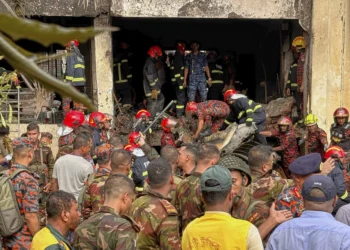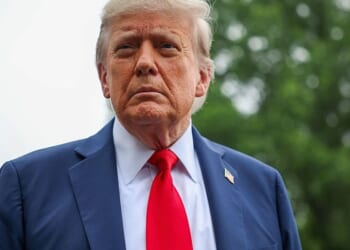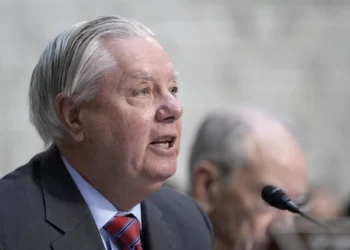The extraordinary pair of meetings in the past week — the Trump-Putin summit in Anchorage, Alaska, on Friday and Trump’s hosting of the leaders of Ukraine, Germany, France, Britain, Italy, Finland, as well as the NATO alliance and the European Commission — were prompted by the latest iteration of a continuing source of instability over hundreds of years.
That instability is Russia‘s westward expansion across the great northern European plains, bereft of natural boundaries, from the principality of Muscovy in the early 1500s to the Soviet empire and satellites ruled by Stalin and his predecessors for nearly half a century after 1945.
Russia’s vast armies, fueled by seemingly limitless manpower, freed much of Europe from the rule of Napoleon in 1815 and Hitler in 1945. However, the Russian proclivity to autocracy and brutal suppression of dissent has been abhorrent to the developing Western traditions of accountable government and ordered liberty.
Readers of Richard Pipes’s magisterial histories of Russia over the years will not need reminding that Russia’s impulse to geographical expansion and autocratic governance has survived the transitions from the tsardom to communism to what is now, theoretically, a democratic republic.
In the 18th century, under Catherine II (originally a German princess), Russia expanded south to Crimea and the Black Sea and westward in the partition of Poland. During World War I, the Kaiser’s Germany pared back its border in March 1918, and Western powers, including the United States, joined Russia’s White Army in trying to oust the communists from 1918 to 1920.
But desultory leadership from the stroke-disabled Woodrow Wilson enabled Lenin and his comrades to cling to power, and communist expansion was stopped for a generation by the new Polish Republic’s Josef Pilsudski on the Vistula, as documented by Adam Zamoyski’s Warsaw 1920.
After signing the Hitler-Stalin pact in August 1939, Stalin proceeded to take over the three Baltic republics (a step the U.S. never legally recognized), eastern Poland, Romania, and Finland. He was about to lunge westward against Hitler, according to Sean McMeekin’s Stalin’s War, when Hitler beat him to the punch and sent 3 million men over the line on June 22, 1941.
Winston Churchill and Franklin Roosevelt immediately began providing material aid, free of cost, to Stalin’s forces, clearly on the theory that their primary goal of destroying Hitler and his regime could be achieved only with the aid of the Red Army and its brutal tactics (shooting any retreating soldier, starving prisoners of war) unavailable to any democratic nation.
From their different viewpoints, Stalin’s War and Tim Bouverie’s Allies at War conclude that Churchill’s and Roosevelt’s broken promises to Stalin of a second front in northern Europe in 1942 and 1943 meant conceding control of much of the continent to Soviet enslavement. Prising a continent from the combined (in 1939 to 1941) forces of Hitler and Stalin required making and following through on tragic choices.
The U.S. continued to make such choices after 1945. It accepted Soviet control where the Red Army was in place, but saved Italy from a Czechoslovakia-type takeover in elections in 1948, extended the nuclear umbrella over western Europe with NATO in 1949, and opposed, with varying results, communist expansion in Korea and Indochina. Steadfastness brought victory in the Cold War, and NATO expansion afterward ended half a century of Russian control of eastern Europe up to and including the Baltics — but not Ukraine.
So, how has Trump fit into this picture? Like Roosevelt, Churchill, and presidents from Harry S. Truman through Ronald Reagan, he has a horror of Americans fighting the Russian army; unlike Roosevelt and Richard Nixon, he sees a greater threat in east Asia than from Russia. Like other presidents, Trump has called for Europe to do more in its own defense. But his much greater emphasis, and because of Putin’s threats, he has gotten results. Most NATO allies are spending more than the pledged 2% gap on defense, and some, led as in 1920 by Poland, are spending much more than that.
POLAND ACCUSES RUSSIA OF ‘PROVOCATION’ AFTER DRONE CRASH ON THE BORDER
Events seem to have moved Trump away, at least temporarily, from the view of some among his supporters (including the vice president?) of Putin’s Russia as a Christian bulwark against woke heresy. His appropriate horror at the brutality of Russian warfare may be overshadowing his appreciation of Putin as a strong leader. He may even be developing an admiration for the resistance against Russian tyranny of the Ukrainian people, perhaps even of Ukrainian President Volodymyr Zelensky.
The extraordinary spectacle of six European heads of government traveling en masse to the White House could turn out to be a key step in the handover of primary responsibility for maintaining Ukraine’s independence to Europe from an America willing to be a backstop but not to take the lead role. Or not. Trump’s inconstancy and avidity for unstinting praise, Putin’s continued determination to inflict destruction on a nation of hearts and minds he has lost, the European governments’ habit of undermining brave declarations with flaccid inaction, and the always unpredictable tides of battle could fail to end the horrifying carnage and spell disaster for the brave and resourceful Ukrainians determined to resist Russian ukase. But for now, there is some reason for optimism on Russia’s often fluctuating western border.














